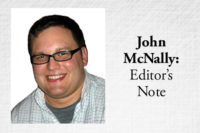Members of the American Society of Plumbing Engineers that made the trek to Chicago got to explore the space of the 2014 ASPE Convention and Exposition at McCormick Place’s Lakeside Center.
On the main floor, visitors were able to stop by more than 300 exhibitor booths and network with key manufacturer personnel and other industry leaders. The booths saw strong foot traffic with plenty of new products and technologies on display. Many manufacturers put forth a concentrated effort to highlight the specific applications their products are best suited for.
While the upper level had the glitz and glamour of the plumbing industry out in full view, one floor below engineers, designers, manufacturers and their reps took part in a variety of educational seminars. On Sept. 23, more than 100 expo attendees filled the conference room for the “The Engineer and Code Official Relationship Regarding Nontraditional Piping Materials” panel discussion.
Moderated by Devin Abellon, P.E., and business-development manager with Uponor North America, the panel discussed best practices on how to navigate the landscape of using products such as PEX, PP-R and others. The panel included:
• Warren Rosenbrook, P.E., CPD of Henderson Engineers (Lenexa, Kan.);
• James Paschal, P.E., LEED AP, Paschal Engineering & Forensic Consulting (Ypsilanti, Mich.);
• Michael Rivers, CPD, product manager for plumbing at Uponor North America (Apple Valley, Minn.);
• Domenic DeCaria, market segment manager with Lubrizol; and
• George Swietczak, CPD, certified plumbing inspector for Lake Zurich, Ill.
Swietczak’s role as an inspector has given him a well-rounded view of how code officials will think about nontraditional products. He told the engineers in attendance to study the codes thoroughly so if a problem arises they are prepared to defend their work.
“There are prejudices against certain materials because officials haven’t done their homework,” he said.
An audience member posed a scenario where he wanted to have a properly-certified nontraditional product installed in an application, but it was still denied by the local code official. Swietczak said to bring proper documentation and be able to convince the official the product is safe to use.
“Engineers and architects can approach code officials,” he says. “You just have to prove how it will protect public health.”
DeCaria added: “Manufacturers will support engineers with materials.”
Another question posed to the manufacturers on the panel was what they were doing to police against substandard – or knockoff products – from overseas. Rivers said manufacturers reps can be a huge help to designers.
“I rely on those NSF markers,” Rosenbrook said. “It’s a big deal what NSF does (to certify) products.”
Legionella discussion
The discussions continued on Sept. 23 starting with Tim Keane, a consulting engineer with Chalfont, Pa.-based Legionella Risk Management. He provided a standing-room-only gathering of attentive listeners with vital information on how to best protect buildings, companies, and most importantly, the safety of the public from the potentially fatal disease.
Keane stated that confirmed reports of Legionella continue to rise and that 25% of outbreaks will occur within the first year the building is fully operational – either in new construction or renovations.
Keane broke some news to the assembled group as well. On Sept. 26, the fourth review of ASHRAE 188 was made available for peer review. There will be a 45-day comment section until Nov. 10 and the entire document is open for review. For more information please see page 18.
“There are going to be some huge changes,” he said. “This is going to be a game-changer. There was a lot added for engineers to figure out, but it will reduce other risks to engineers. Engineers and manufacturers are the first to be sued (if there is a Legionella case).”
He added: “You will see Legionella on many company product brochures (at the next ASPE Expo).”
Keane said engineers can prevent Legionella outbreaks in their designs if they follow sound techniques. “Temperature and flow matter the most,” he said. “Remember to keep water hot; at least above 122° F. If you have low temperature and low flow, you’ll make it worse.”
Life-cycle analysis
After a short break, Terry Thiele, a strategic planner of supports and legislative and regulatory advocacy with Lubrizol, held his “Future of Environmental Plumbing Design” discussion for about 90 members.
Thiele started discussing “greenwashing,” which is defined as green marketing deceptively used to promote an organization’s products or policies as environmentally friendly when in reality those are not the case. He said environmental groups such as Greenpeace – which Thiele described as the most extreme environmental group – will self-police companies’ polices.
Thiele recommends manufacturers invest in life-cycle analyses, which look at the total life of all products. There are four points to an LCA: goal definition and scoping, inventory analysis, impact assessment and interpretation.
The final goal of an LCA is to discover “toxicity” of a product and where in its life does it cause the most harm to the environment. That could be during the manufacturing process, the end-use or the disposal of any product. Thiele said the price tag of an LCA can be steep, but it’s critical to work with trusted industry veterans that will provide the best information.
“LCAs are not cheap,” he said. “You have to be consistent. Use a professional that has a reputation to uphold.”
Drawing the curtain
Dallas-based Kelvin Kennedy, a certified plumbing designer with Telios Corp., who took in Thiele’s panel discussion, said the work being done in the ASPE educational programs is critical for the advancement of the industry.
“The sessions have always been the blood of our organization,” he said. “We can take the knowledge we know as plumbing designers and pass it on to those that don’t get to come to these events often.”
ASPE President William Hughes, of North Dartmouth, Mass.-based Creative Environment Corp., said he took in as much of the event as his busy schedule allowed. Hughes gave high praise to the city of Chicago and was pleased to hear expo visitors got a lot out of the event.
“Chicago is great city,” he said. “It’s nice to hear the attendees are happy with the show.”




